
The Rose-ringed parrot/Indian ringneck parrot ( Psittacula krameri ) is a species of large parakeet of Afro-Asian origin today acclimatized to Western Europe. The species is named after the Austrian naturalist Wilhelm Heinrich Kramer.
Indian ringneck is often bred in captivity for the beauty of its plumage, and populations returned to the wild now exist in the United Kingdom, France, Belgium, Spain, Portugal, and Italy.
Description
A female Indian ringneck in Baden-Württemberg . March 2018. The Rose-ringed parrot measures 40 to 41 cm in length with a wingspan of 47 cm and a mass of 117 g. It is a parakeet very widespread in the world. It has predominantly green plumage and a distinctive call; it is said to be hissing or chatting.
The tail is long and has azure blue undertones. The belly and the underside of the wings are yellowish. A black line connects the cere (base of the beak) to the eyes. The upper mandible of the bill is red, while the lower is black.
There is a sexual dimorphism:
- The male Rose-ringed parrot/Indian ringneck is distinguished by a black collar extending from the beak to the neck as well as by a thin red band on the nape;
- Females Rose-ringed parrot/Indian ringneck and juveniles of both sexes (up to age 3) are often paler and have shorter tails; they do not present a collar or else a simple gray shading and light bands on the nape (always of the same color but of shades paler than the surrounding plumage).
Behavior
The flight is quick and direct, associated with screaming during group flights.
Rose-ringed parrots (Indian ringneck) are gregarious during their feeding and breeding periods. They gather at nightfall on a dormitory tree to spend the night there. In the early morning, they fly away to feed. During the breeding season (March-April), the roost is generally abandoned in favor of breeding sites until the fall.
Reproduction
Rose-ringed parakeet or Rose-ringed parrot or Indian ringneck at the entrance to its nest ( Ranthambore National Park ).
The nesting is called cavernicole, which means that the eggs are laid in crevices, often in hollow trees. Old plane trees are often used. Clutches are 2 to 6 eggs that are incubated for 21 days. The young, usually 2-3, are fed in the nest for about 40 days.
Longevity
The life expectancy is around thirty years in captivity.
Food
The ring-necked parakeet or Rose-ringed parrot or Indian ringneck feeds mainly on fruits and seeds. She’s an opportunist. In Africa, its diet is based on fruits (such as those of Ficus and baobab trees, figs, mangoes, and guavas ) and seeds.
In Europe, the species prefers urban environments where the temperature is higher and where it can find its sustenance (fruits, seeds, shoots), in particular in bird feeders.
For the moment, therefore, it is not blamed for significant damage to harvests in Europe. On the other hand, it is considered to be a plague for the cereal and fruit crops in Asia.
In captivity, the favorite food of this bird consists of various plants ( almonds, peanuts, berries, cereals, edible flowers, fruits, seed and/or legume germs, vegetables, very cooked legumes, nuts, al dente pasta, quinoa, rice, greenery …).
Indian ringneck breeders [Indian redneck parakeet]
SOURCE:BirdTricks
Natural Distribution and subspecies
Rose-ringed parrot or Indian ringneck parrot at Syon Park.
The Indian ringneck parrot naturally inhabits tree savannas and tropical cultivated areas in Africa and Asia. She is sedentary. The species Psittacula krameri is subdivided into four subspecies that are very similar morphologically but have different distribution areas:
In Africa
- P. k. krameri , commonly known as the parakeet-necked-African or African ringneck nominal (Scopoli, 1769) localized from Senegal to western Uganda and southern Sudan;
- P. k. parvirostris , commonly known as the Abyssinian-collared parakeet (Souance, 1856) located from eastern Sudan to northern Ethiopia and Somalia.
In Asia
- P. k. borealis , commonly known as Neumann’s collared parakeet (Neumann, 1915) located from eastern Pakistan to Myanmar;
- P. k. manillensis , commonly known as the Indian-collared parakeet (Bechstein, 1800) located in southern India and Sri Lanka.
The morphological differences between subspecies are minor and concern the size of the bird, that of its beak, and the color of the latter.
The genus Psittacula includes 15 species of parakeets including the very rare Mauritius parakeet ( Psittacula echo ), strictly localized in Mauritius, and the large parakeet Alexander ( Psittacula eupatria ).
Poultry farming
Indian ringneck parrots or Rose-ringed parrots are very popular with breeders. They are sturdy and easy to raise. Indian ringnecks are mainly of the subspecies P. k. manillensis , more rarely Pk borealis and P. k. krameri . Ring-necked parakeets or Indian ringneck parrots established in Europe are most likely liberated or escaped breeding parakeets. Many mutations in the color of the plumage have been selected: lutino, blue, turquoise blue, albino, crème-ino, cinnamon, lacewing, buttercup …
- Examples of color mutations by breeding
Blue Indian ringneck parrot
- Blue mutation.
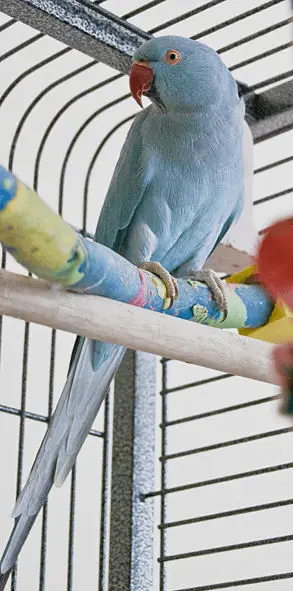
- Turquoise-green and turquoise lacewing (rare mutations)/green indian ringneck.
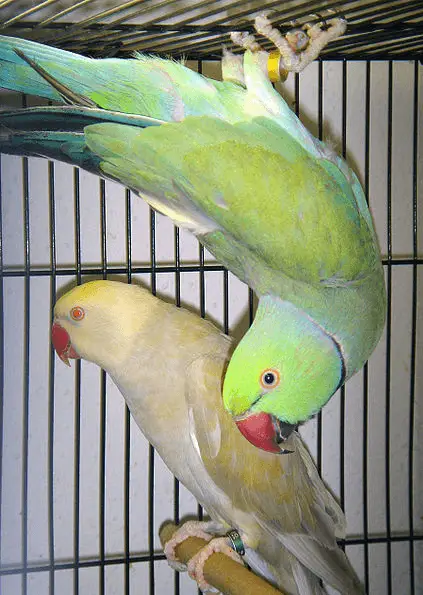
- lutino and cinnamon turquoise (juveniles).
Yellow indian ringneck parrot
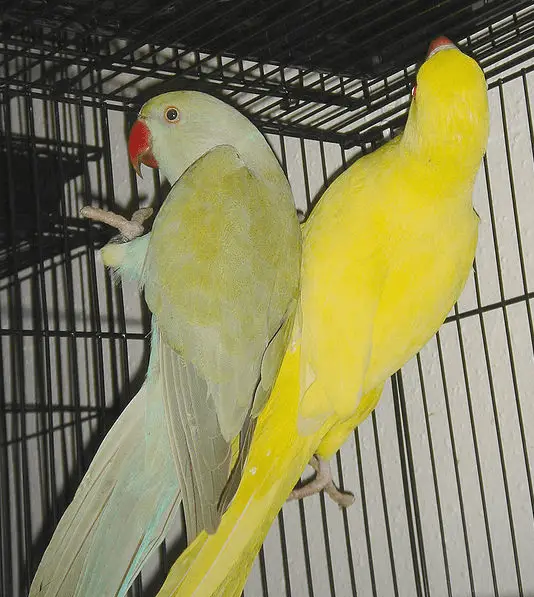
- Albino
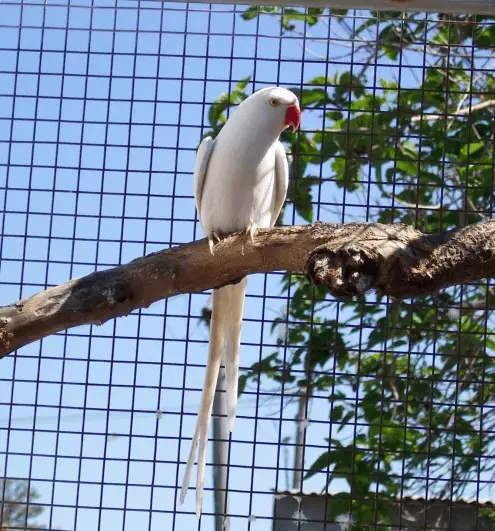
The Indian ringneck parrot or Rose-ringed parrot has been introduced to Europe and America from its natural range. Feral populations exist in England (around 50,000 individuals in London),
in Spain (especially in Andalusia and Catalonia), in Italy (Genoa, Milan, Rome, Florence, Syracuse, Bolzano / Bolzen, etc.), in Germany (Cologne, Bonn), in the Netherlands (Amsterdam, Utrecht, Leyden ) and in some cities of Europe, recently we have seen several roaming free in Casablanca in Morocco in a public garden in the city center ( Murdoch Park ).
The Rose-ringed parrot or Indian ringneck parrot is sometimes considered an invasive species, However, a large scientific study published in 2019 shows that this parakeet’s competition with other birds is very relative and Reporter magazine considers that it should not be qualified as an invasive species.
In Brussels, for example, the population of ring-necked parakeets is estimated at several thousand individuals and is expanding rapidly.
Some specialists are concerned about competition with local avian species such as the house sparrow, the Eurasian nuthatch, and the common starling whose nesting habits are similar, or with bat species such as the large nocturnal. The origin of the Brussels population dates back to 1973-1974.
Forty ring-necked parakeets/Indian ringneck parrot take flight from Meli Park Heysel zoo. Forty years later, they reproduced and their number is estimated at over 8,000 individuals.
It has also been present in Île-de-France for several years, increasing from 1,100 individuals in 2008 to more than 5,000 in 2016, particularly in parks and gardens; they were first reported near Orly and Charles-de-Gaulle airports, through which they probably arrived. They are also found in the south of France as well as in other French cities such as in the suburbs of Lille or Nancy.
Indian Ringneck Parakeets as Pets and Living with an Indian Ringneck | Species Spotlight
SOURCE:Love of Pets
Indian ringneck parakeet
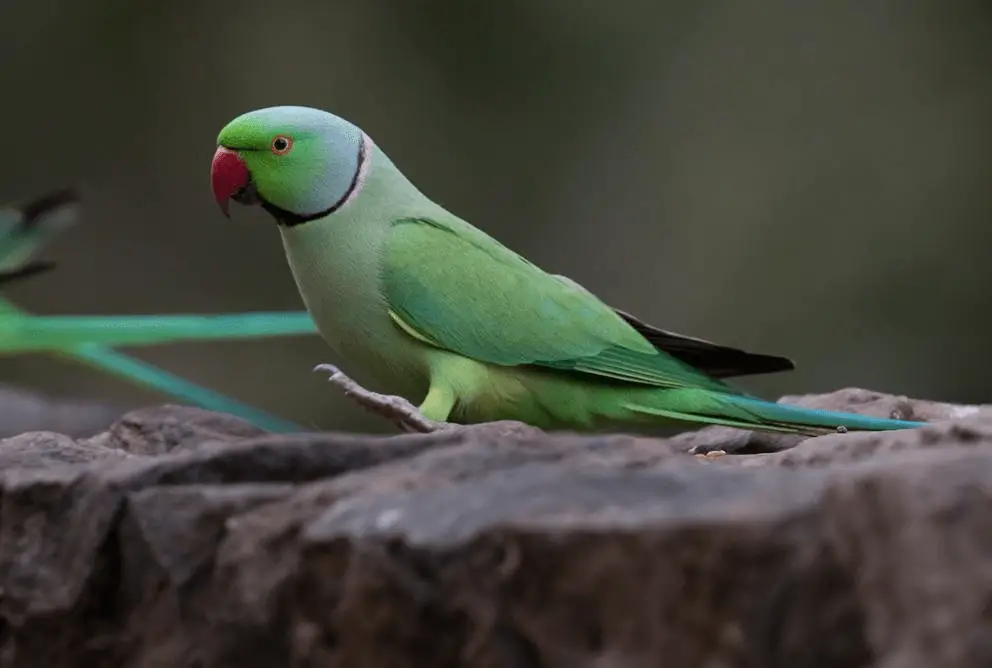
Rose-ringed parakeet Order: Psittaciformes
Famille: Psittacidae
Not subject to annexes
No sexual dimorphism
Phenotype:
- Large red beak green indian ringneck and triple color necklace (black, pink, and blue) extending from the lower beak to the nape of the neck
- The female is without a collar but it is necessary to wait until the 2 years old so that the necklace of the young male begins to appear
Character: a very gregarious bird character that can be kept in a group. Cries carry far and can be a source of trouble neighborhoods. Capable to say a few words.The necessity to have permanent gnawing braches.
Weight: 95 – 140g
Rose-ringed parrot

Rose-ringed parrot
SOURCE:Joys of Nature
Rose-ringed parrot (Psittacula Krameri)
has become more and more popular as pets in recent years and for many reasons. On the one hand, these birds are known to be exceptional talkers, with some vocabularies amassed many words that they can speak with incredible clarity. Combined with their beauty and average size, these features make them attractive companion birds for a growing population of bird lovers. If you would like to know more about these precious parrots, check out the information below. This will give you an idea of some of the fascinating features that these birds possess and will help you learn a little more about what it means to live with a pet. They are indeed a beautiful species and deserve the respect they receive.
The Indian ringneck parrot can be very affectionate
Although necked parakeets have been considered for many years as a kind of “ornamental” bird, those who have come to know and love them have discovered that, in fact, these birds can become animals of their own. loving and loving company when handled by hand like babies and properly bred. Not only does Ringneck love pets, but they thrive in environments where they are properly socialized, interacting, and trained regularly.
Collared parakeets have a phase of “bluffing”
Like some other types of birds, the young parakeets undeniably went through a so-called “bluffing” phase during their teenage years. This is due to the hormonal changes that occur during this stage of the bird’s life and sometimes it can, unfortunately, prevent inexperienced owners from interacting with their birds, resulting in a loss of desired behaviors. The key to getting through the bluffing phase is not to give up and continue working with your bird throughout these hormonal stages. While a bluffing bird will put your patience to the test, time and time again, those who are able to pass through the phase have proved that eventually, will pass!
Collared parakeets are parrots
Although they are identified as parakeets, Indian Ringnecks, like all parakeets, are also parrots. Many think that these birds have been tagged parakeets because of their average size, while other bird lovers say they should be called parakeets because of their long, beautiful tail. Still, others refer to these birds as Indian Ringed Parrots, which is perhaps the most precise terminology of all. Whichever way you choose to refer to an Indian Ringneck, they are actually hooked birds that match all the characteristics used to describe the true members of the parrot family.
The Indian ringneck parrot is an excellent speaker
While it is not easy to be 100% sure that you will choose a bird that will speak by choosing to adopt a collared Indian parakeet, it can certainly increase your chances. Their voice is one of the most charming among parrot pet birds. It’s a high-pitched and comical voice that will not fail to make you laugh and make them interact with you.
In fact, these birds were once considered sacred in their home countries because of their remarkable conversation skills. Long ago, religious leaders in India watched the birds repeat prayers that were recited daily in the gardens surrounding their places of worship. There is no doubt that the clarity of language for which this species is known has greatly increased its popularity as a pet in India and around the world.
Collared parakeets have a variety of colors
Collared parakeets have a normal green color with the exception of turquoise blue on their plumage and black and pink rings around the necks of males. However, captive breeding programs have resulted in a number of beautiful color mutations within the species. This has led to the availability of blue, yellow (lutino) and white Indian Ringnecks, among other colors and striking color combinations. In many places, the color of mutated birds has become even more popular than that of wild birds, although the normal green color is bright and beautiful.
Rose-ringed parrot
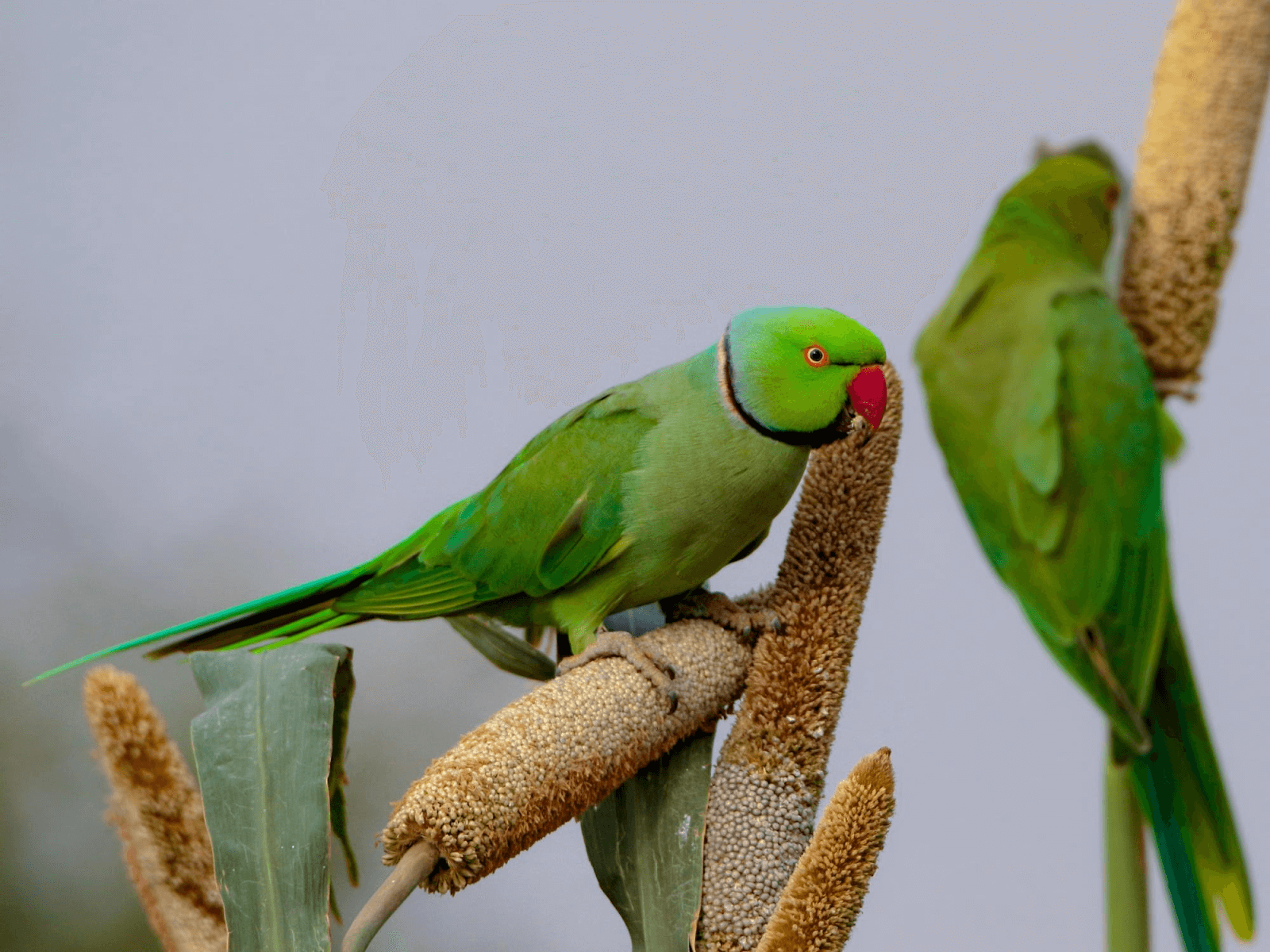
Indian Ringneck parrot
Indian ringneck parakeet lifespan
Indian Ringneck Parrot Life Span:
Indian ringneck parakeets in captivity can live to be 20 to 30 years old, These are called hardy birds. They can survive in hard conditions. But, they need good care for a better life span. Their natural life span is 20 to 30 years There are some reports of ringnecks living up to 50 years.
Indian ringneck price
Indian Ringnecks cost about an average of $400 – $500 though you can expect to pay up to $700 depending on the organization and the bird
Indian ringneck parrot talking
SOURCE:Fatma Hasan
How much does an Indian ringneck parrot cost?
$400 – $500
Do Indian ringneck parrots make good pets?
Only if hand-fed and socialized by a breeder producing for the pet market. Indian ringneck parrot can make fantastic pets but will be extremely handed shy and easily stressed if parent or colony reared (raised by parents only, or parents as part of a big group of birds with no human contact) or creche raised (hand raised as a group) with minimal human attention.
Buying a non-socialized animal who is bred for color and further breeding programs will not make a rewarding pet.
Adorable ring necks who hop across the house following their people on YouTube behave very differently than the bird that was not socialized.
Indian ringneck parrots are not domesticated, so a lot of their behavior depends on early learning and their flexible nature rather than an inbred need to be with you and please you. Five days of cuddles during weaning from the breeder will do wonders that five weeks of training an adult will not.
There is a cost increase associated with a hand-raised AND socialized bird. “Hand fed” does not mean good pet unless the breeder spends time with the babies. Co-parented babies are unusual in ringnecks, where human and bird parents both raise the baby, so you can’t expect to find them.
A socialized ringneck is a wonderful companion animal for a dedicated exotic animal owner. But a non socialized ring neck kept alone in a cage is going to be a stressed-out, unhappy mess.
Your breeder or pet shop who hand rears from a breeder can introduce you to current ring neck parakeet owners to help you make informed decisions from spending time with an owner and their adult indian ringneck.
How big does an Indian ringneck parrot get?
Anything around the 110-120gram areas are fine for Adult birds.
Length: 40-42 cm is an average
16 inches long
Can Indian ringnecks talk?
First, you have to understand that not every parrot can talk. The Indian Ringneck parrot however is special in this regard. It’s a highly intelligent creature compared to other members of its species.
Indian ringneck parrot can learn words easily and is an excellent talker. It has been shown that Ringneck parrots can learn and memorize around 200–250 words easily.
Even though it is known for its excellent speech qualities, some parrots may not talk ever in their lifetimes. So don’t be disheartened or force your bird into it.
Now since you want to train your bird to talk here are some steps that you can do to make it happen eventually:
Step 1: Build up trust
Animals are a lot like humans. They are more comfortable with people that they know and trust. So start on it. Spend a lot of time with your bird.
Love it, caress it and play with it from time to time. Since Ringnecks are highly intelligent birds, they will easily sense your emotions and intentions and reciprocate in the same way.
So get your little one to trust and love you and soon it will be wanting to communicate with you in no time.
Step 2: Rewards
Remember how our parents used to coerce us into studying and we would rebel all the more when forced into it? But when they lured us with the promise of a new bicycle on getting good marks, we would sit our asses to study for long hours just to get that bike.
The same situation is with animals. Reward their positive behavior so that they know and understand that yes this is something that I need to do for getting something good in return.
In the beginning, the rewards can be your pet’s favorite food. With progress, you can change the rewards into other things that your pet likes, like a massage on its head, a water bath, etc.
Step 3: Use Sounds
As time progresses you can buy an audiobook easily available online. They play the same words in a loop which can help train the bird. Or you can create your own audio files and play them. This will help train the bird in no time.
Last but not the least, be extra patient. Birds need their time. Do not be hasty and get frustrated when you don’t see it talk. It will take some time.
Remember, it’s your bird. It is a part of your life. So always care for it as a member of the family and not as a pet.




















